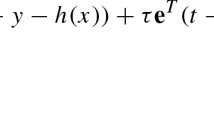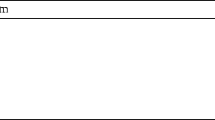Abstract
In this paper, we consider four optimization models for solving the Linear Complementarity (LCP) Problems. They are all formulated as DC (Difference of Convex functions) programs for which the unified DC programming and DCA (DC Algorithms) are applied. The resulting DCA are simple: they consist of solving either successive linear programs, or successive convex quadratic programs, or simply the projection of points on \(\mathbb{R}_{+}^{2n}\). Numerical experiments on several test problems illustrate the efficiency of the proposed approaches in terms of the quality of the obtained solutions, the speed of convergence, and so on. Moreover, the comparative results with Lemke algorithm, a well known method for the LCP, show that DCA outperforms the Lemke method.
Similar content being viewed by others
References
Ahn, B.-H.: Iterative methods for linear complementarity problems with upper bounds on primary variables. Math. Program. 26, 295–315 (1983)
Chen, X., Ye, Y.: On smoothing methods for the P 0 matrix linear complementarity problem. SIAM J. Optim. 11(2), 341–363 (2000)
Cottle, R., Pang, J., Stone, R.: The Linear Complementarity Problem. Academic Press, San Diego (1992)
Fathi, Y.: Computational complexity of LCPs associated with positive definite symmetric matrices. Math. Program. 17, 335–344 (1979)
Fernandes, L., Friedlander, A., Guedes, M.C., Judice, J.: Solution of a general linear complementarity problem using smooth optimization and its application to bilinear programming and LCP. Appl. Math. Optim. 43, 1–19 (2001)
Fletcher, R.: Practical Methods of Optimization. Wiley, New York (1987). ISBN13:978-0471494638
Floudas, C.A., et al.: Handbook of Test Problems in Local and Global Optimization. Nonconvex Optimization and Its Applications, vol. 33. Kluwer Academic, Dordrecht (1999). XV
Judice, J., Faustino, A.M., Ribeiro, I.M.: On the solution of NP-hard linear complementarity problems. Top 10(1), 125–145 (2002)
Geiger, C., Kanzow, C.: On the resolution of monotone complementarity problems. Comput. Optim. Appl. 5(2), 155–173 (1996)
Krause, N., Singer, Y.: Leveraging the margin more carefully In: Proceedings of the 21st International Conference on Machine Learning, ICML, 2004, Banff, Alberta, Canada, p. 63 (2004). ISBN:1-58113-828-5
Le Thi, H.A., Pham Dinh, T.: Solving a class of linearly constrained indefinite quadratic problems by DC algorithms. J. Glob. Optim. 11(3), 253–285 (1997)
Le Thi, H.A., Pham Dinh, T.: The DC (difference of convex functions) programming and DCA revisited with DC models of real world nonconvex optimization problems. Ann. Oper. Res. 133, 23–46 (2005)
Liu, Y., Shen, X., Doss, H.: Multicategory ψ-learning and support vector machine: computational tools. J. Comput. Graph. Stat. 14, 219–236 (2005)
Murty, K.G.: Linear Complementarity, Linear and Nonlinear Programming. Sigma Series in Applied Mathematics, vol. 3. Heldermann, Berlin (1988),
Pardalos, P.M.: The linear complementarity problem. In: Gomez, S., Hennart, J.P. (eds.) Advances in Optimization and Numerical Analysis, pp. 39–49. Kluwer Academic, Norwell (1994).
Pardalos, P.M., Rosen, J.B.: Global optimization approach to the linear complementarity problem. SIAM J. Sci. Stat. Comput. 92, 341–353 (1988)
Pardalos, P.M., Vavasis, S.A.: Quadratic programming with one negative eigenvalue is NP-hard. J. Glob. Optim. 1(1), 15–22 (1991)
Pardalos, P.M., Ye, Y.: A class of linear complementarity problems solvable in polynomial time. Linear Algebra Appl. 152, 3–17 (1991)
Pham Dinh, T., Le Thi, H.A.: Convex analysis approach to d.c. programming: theory, algorithms and applications. Acta Math. Vietnam. 22(1), 289–355 (1997)
Pham Dinh, T., Le Thi, H.A.: D.c. optimization algorithms for solving the trust region subproblem. SIAM J. Optim. 8(2), 476–505 (1998)
Ronan, C., Fabian, S., Jason, W., Léon, B.: Trading convexity for scalability. In: Proceedings of the 23rd International Conference on Machine Learning, ICML 2006, Pittsburgh, Pennsylvania, pp. 201–208 (2006). ISBN:1-59593-383-2
Schnörr, C., Schüle, T., Weber, S.: Variational reconstruction with DC-programming. In: Herman, G.T., Kuba, A. (eds.) Advances in Discrete Tomography and Its Applications. Birkhäuser, Boston (2007)
Schüle, T., Schnörr, C., Weber, S., Hornegger, J.: Discrete tomography by convex-concave regularization and d.c. programming. Discrete Appl. Math. 151, 229–243 (2005)
Sherali, H., Krishnamurty, R., Al-Khayyal, F.: Enumeration approach for linear complementarity problems based on a reformulation-linearization technique. J. Optim. Theory Appl. 99, 481–507 (1998)
Zhao, Y.-B., Li, D.: A globally and locally superlinearly convergent non-interior-point algorithm for P0 LCPs. SIAM J. Optim. 13(4), 1195–1221 (2003)
Author information
Authors and Affiliations
Corresponding author
Rights and permissions
About this article
Cite this article
Le Thi, H.A., Pham Dinh, T. On solving Linear Complementarity Problems by DC programming and DCA. Comput Optim Appl 50, 507–524 (2011). https://doi.org/10.1007/s10589-011-9398-y
Received:
Published:
Issue Date:
DOI: https://doi.org/10.1007/s10589-011-9398-y




